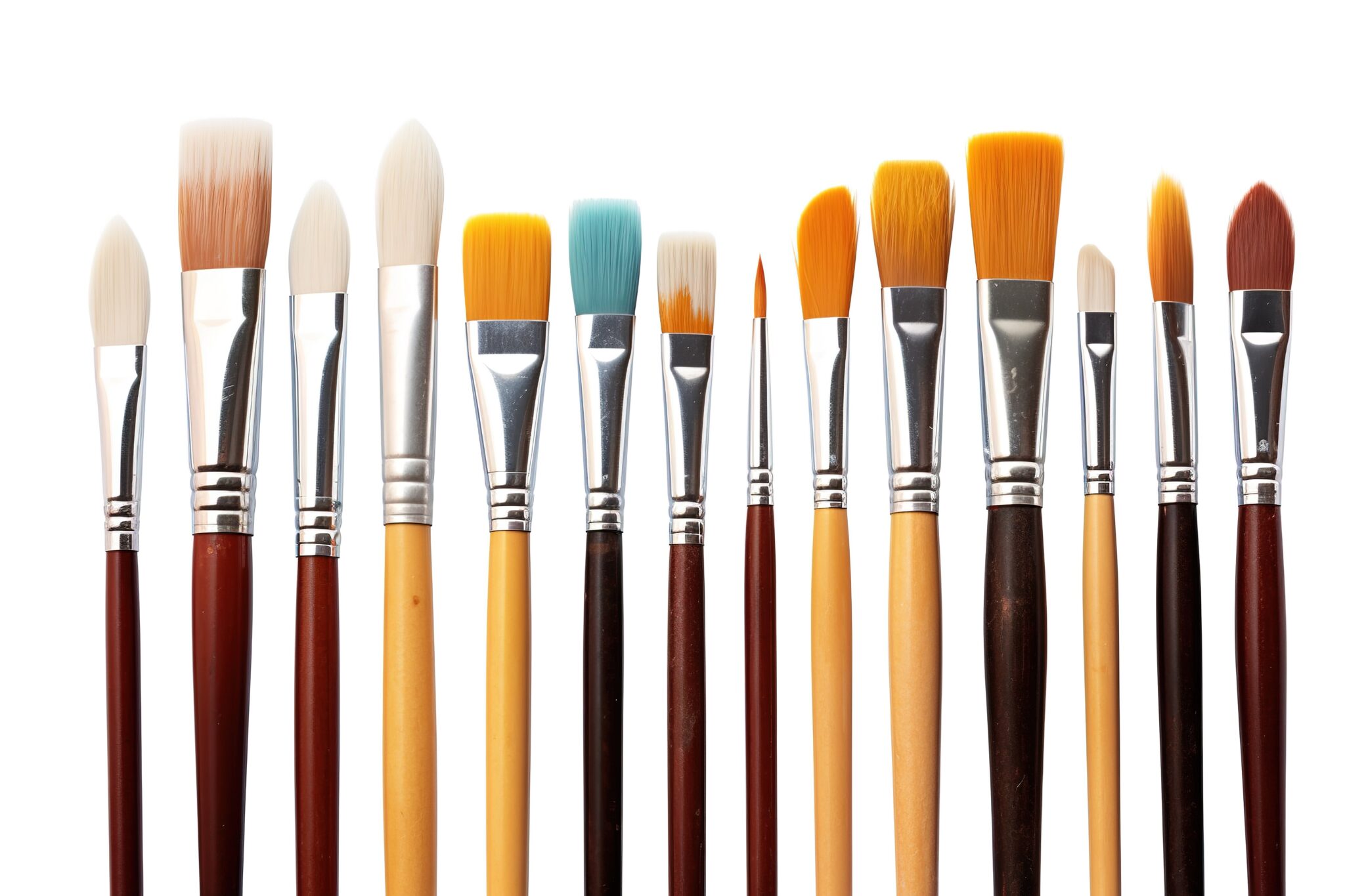The brush is one of the most fundamental tools in an artist’s arsenal, and its shape, size, and bristle type can significantly impact the artistic process and outcome. Understanding the unique attributes of different brush types allows artists to select the right tools for their desired effects, techniques, and styles. In this guide, we will explore various brush types, their characteristics, and how each can contribute to your artistic expression.
1. Common Brush Types and Their Unique Attributes
A. Flat Brush
Characteristics:
- Shape: A rectangular head with a flat edge.
- Bristle Arrangement: Typically stiff, which allows for greater control.
Unique Attributes:
- Bold Strokes: The flat brush is excellent for making broad, sweeping strokes and covering larger areas quickly, which is particularly useful for backgrounds in landscapes and abstracts.
- Defined Edges: It can create sharp lines and angles, making it ideal for geometric designs or architectural details.
- Texture Creation: When used with less paint, it can produce textured effects, enhancing organic elements like foliage or rocky surfaces.
B. Round Brush
Characteristics:
- Shape: Tapered and pointed, with a round head.
- Bristle Arrangement: Bristles can vary from soft to stiff, creating a range of effects based on the type chosen.
Unique Attributes:
- Versatile Stroke Width: This brush can create both fine lines and broader strokes depending on how much pressure is applied, making it invaluable for diverse painting styles.
- Detail Work: Ideal for intricate details in floral compositions, skin tones, and textures. The pointed tip allows for precision in areas requiring focus.
- Blending: Ideal for blending colors together, especially in portrait painting or natural scenes.
C. Filbert Brush
Characteristics:
- Shape: Oval with rounded edges, blending properties of both flat and round brushes.
- Bristle Arrangement: Typically softer, allowing for smoother applications.
Unique Attributes:
- Soft Blending: The filbert brush excels in creating soft transitions between colors, making it perfect for skin tones and delicate scenery.
- Petal Shapes: Its shape is great for achieving rounded details or petals in floral painting, allowing for curvy strokes that resemble natural forms.
- Controlled Coverage: Offers versatility for both detailed and broader applications without sacrificing edge quality.
D. Angular Brush
Characteristics:
- Shape: Slanted head, ideal for creating angular strokes.
- Bristle Arrangement: Bristles can be stiff or soft, depending on the intended use.
Unique Attributes:
- Sharp Edges: This brush is perfect for creating precise lines, such as the edges of buildings or the sharp angles of geometric shapes.
- Versatile Blending: Offers an excellent tool for blending multiple colors at an angle, enhancing depth in your work.
- Dynamic Strokes: Great for adding interest to landscapes or portraits with diagonal strokes that imply movement or direction.
E. Rigger Brush
Characteristics:
- Shape: Long, thin bristles, designed for fine detailing.
- Bristle Arrangement: Specialized for precision work.
Unique Attributes:
- Fine Lines and Details: The rigger brush is ideal for creating delicate lines, like tree branches, hair, and other intricate patterns in your work.
- Fluidity: Capable of producing graceful, continuous strokes due to its length, it’s excellent for painting flowing elements.
- Highlighting and Accents: Ideal for adding highlights and final touches that require precision.
F. Fan Brush
Characteristics:
- Shape: Fanned-out bristles arranged in a semicircular shape.
- Bristle Arrangement: Generally soft and flexible.
Unique Attributes:
- Texturing: Exceptional for creating textures such as fur, grass, or foliage. The fan shape allows for natural-looking strokes that mimic organic forms.
- Blending: Can also be used for blending colors smoothly, especially in creating clouds or soft backgrounds.
- Dabbing Technique: Performs well with dabbing motions, allowing for the rapid layering of colors and forms.
2. Choosing the Right Brush for Your Style
A. Consider Your Medium
- While many of the brushes listed above can be used with various mediums (acrylic, oil, watercolor), some perform better with specific types. For instance, be sure to consider the bristle material and resilience when choosing brushes for acrylic painting, as synthetic options often hold up better.
B. Explore Techniques
- Experiment with different brush types to discover how each can affect your style. For instance, a flat brush offers bold application while a rigger brush allows for nuances and details. Mixing brush types can yield dynamic results in a single artwork.
C. Assess Stroke Preferences
- If you prefer fine details and delicate work, select brushes like the rigger or round brush. For broader strokes and textures, the flat or filbert brush would suit your approach.
3. Conclusion
Understanding the unique attributes of different brush types enables artists to make informed decisions about the tools they use, allowing for greater creative expression and painting versatility. By experimenting with various brushes—flat, round, filbert, angular, rigger, and fan—you can discover the possibilities they offer and how they can enhance your artistic practice.
Explore our wide selection of high-quality brushes and essential art supplies at urartstudio.com to find the perfect tools for your creative endeavors!
Be sure to visit our online store at https://urartstudio.com/shop/ for a variety of art supplies and tools. Additionally, check out valuable painting tips at urartstudio.com/painting-tips/ and our step-by-step painting instructions at https://urartstudio.com/step-by-step-painting-instructions/ to further enhance your skills.
Keywords: brush types, painting techniques, artist tools, art supplies.
#BrushTypes #ArtisticExpression #PaintingTechniques #ArtSupplies #CreativeTools



Leave a Reply
You must be logged in to post a comment.